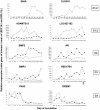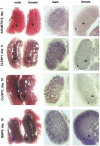Gene expression profiling reveals new potential players of gonad differentiation in the chicken embryo
- PMID: 21931629
- PMCID: PMC3170287
- DOI: 10.1371/journal.pone.0023959
Gene expression profiling reveals new potential players of gonad differentiation in the chicken embryo
Abstract
Background: In birds as in mammals, a genetic switch determines whether the undifferentiated gonad develops into an ovary or a testis. However, understanding of the molecular pathway(s) involved in gonad differentiation is still incomplete.
Methodology/principal findings: With the aim of improving characterization of the molecular pathway(s) involved in gonad differentiation in the chicken embryo, we developed a large scale real time reverse transcription polymerase chain reaction approach on 110 selected genes for evaluation of their expression profiles during chicken gonad differentiation between days 5.5 and 19 of incubation. Hierarchical clustering analysis of the resulting datasets discriminated gene clusters expressed preferentially in the ovary or the testis, and/or at early or later periods of embryonic gonad development. Fitting a linear model and testing the comparisons of interest allowed the identification of new potential actors of gonad differentiation, such as Z-linked ADAMTS12, LOC427192 (corresponding to NIM1 protein) and CFC1, that are upregulated in the developing testis, and BMP3 and Z-linked ADAMTSL1, that are preferentially expressed in the developing ovary. Interestingly, the expression patterns of several members of the transforming growth factor β family were sexually dimorphic, with inhibin subunits upregulated in the testis, and bone morphogenetic protein subfamily members including BMP2, BMP3, BMP4 and BMP7, upregulated in the ovary. This study also highlighted several genes displaying asymmetric expression profiles such as GREM1 and BMP3 that are potentially involved in different aspects of gonad left-right asymmetry.
Conclusion/significance: This study supports the overall conservation of vertebrate sex differentiation pathways but also reveals some particular feature of gene expression patterns during gonad development in the chicken. In particular, our study revealed new candidate genes which may be potential actors of chicken gonad differentiation and provides evidence of the preferential expression of BMPs in the developing ovary and Inhibin/Activin subunits in the developing testis.
Conflict of interest statement
Figures





Similar articles
-
Dynamics of the transcriptional landscape during human fetal testis and ovary development.Hum Reprod. 2020 May 1;35(5):1099-1119. doi: 10.1093/humrep/deaa041. Hum Reprod. 2020. PMID: 32412604
-
Isolation and characterization of sexual dimorphism genes expressed in chicken embryonic gonads.Acta Biochim Biophys Sin (Shanghai). 2009 Apr;41(4):285-94. doi: 10.1093/abbs/gmp012. Acta Biochim Biophys Sin (Shanghai). 2009. PMID: 19352543
-
A comprehensive transcriptional profiling of developing gonads reveals the role of TGFβ signaling in female gonadal asymmetry in chickens.Poult Sci. 2025 Apr;104(4):104932. doi: 10.1016/j.psj.2025.104932. Epub 2025 Feb 20. Poult Sci. 2025. PMID: 40014972 Free PMC article.
-
Sex determination and gonadal sex differentiation in the chicken model.Int J Dev Biol. 2018;62(1-2-3):153-166. doi: 10.1387/ijdb.170319cs. Int J Dev Biol. 2018. PMID: 29616724 Review.
-
Phenotypic manifestations during the development of the dominant and default gonads in mammals and birds.J Exp Zool. 1998 Aug 1;281(5):466-71. J Exp Zool. 1998. PMID: 9662833 Review.
Cited by
-
Association of Somatic Mutations of ADAMTS Genes With Chemotherapy Sensitivity and Survival in High-Grade Serous Ovarian Carcinoma.JAMA Oncol. 2015 Jul;1(4):486-94. doi: 10.1001/jamaoncol.2015.1432. JAMA Oncol. 2015. PMID: 26181259 Free PMC article.
-
Genome-wide identification, evolution and expression analysis of bone morphogenetic protein (BMP) gene family in chinese soft-shell turtle (Pelodiscus sinensis).Front Genet. 2023 Feb 1;14:1109478. doi: 10.3389/fgene.2023.1109478. eCollection 2023. Front Genet. 2023. PMID: 36816024 Free PMC article.
-
Whole-Transcriptome Analysis Identifies Gender Dimorphic Expressions of Mrnas and Non-Coding Rnas in Chinese Soft-Shell Turtle (Pelodiscus sinensis).Biology (Basel). 2022 May 29;11(6):834. doi: 10.3390/biology11060834. Biology (Basel). 2022. PMID: 35741355 Free PMC article.
-
Novel Heredity Basis of the Four-Horn Phenotype in Sheep Using Genome-Wide Sequence Data.Animals (Basel). 2023 Oct 10;13(20):3166. doi: 10.3390/ani13203166. Animals (Basel). 2023. PMID: 37893889 Free PMC article.
-
Investigation into the association of FNDC1 and ADAMTS12 gene expression with plumage coloration in Muscovy ducks.Open Life Sci. 2024 Jun 11;19(1):20220877. doi: 10.1515/biol-2022-0877. eCollection 2024. Open Life Sci. 2024. PMID: 38867923 Free PMC article.
References
-
- Smith CA, Roeszler KN, Ohnesorg T, Cummins DM, Farlie PG, et al. The avian Z-linked gene DMRT1 is required for male sex determination in the chicken. Nature. 2009;461:267–271. - PubMed
-
- Smith CA, Roeszler KN, Sinclair AH. Genetic evidence against a role for W-linked histidine triad nucleotide binding protein (HINTW) in avian sex determination. Int J Dev Biol. 2009;53:59–67. - PubMed
-
- Tsunekawa N, Naito M, Sakai Y, Nishida T, Noce T. Isolation of chicken vasa homolog gene and tracing the origin of primordial germ cells. Development. 2000;127:2741–2750. - PubMed
-
- Hamburger V, Hamilton HL. A series of normal stages in the development of the chick embryo. 1951. Dev Dyn. 1992;195:231–272. - PubMed
-
- Hughes GC. The Population of Germ Cells in the Developing Female Chick. J Embryol Exp Morphol. 1963;11:513–536. - PubMed
Publication types
MeSH terms
LinkOut - more resources
Full Text Sources
Miscellaneous

